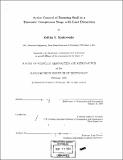Active control of rotating stall in a transonic compressor stage with inlet distortion
Author(s)
Spakovszky, Zoltán S. (Zoltán Sándor), 1972-
DownloadFull printable version (5.624Mb)
Advisor
James D. Paduano.
Terms of use
Metadata
Show full item recordAbstract
Rotating stall has been stabilized in a single-stage transonic axial flow compressor with inlet distortion using active feedback control. The experiments were conducted at the NASA Lewis Research Center on a single-stage transonic core compressor. An annular array of 12 jet-injectors located upstream of the rotor tip was used for forced response testing and to extend the compressor stable operating range. Results for radial and circumferential inlet distortion are reported. First, the effects of radial distortion on the compressor performance and the dynamic behavior were investigated. Control laws were designed using empirical transfer function estimates determined from forced response results. The transfer functions indicated that the compressor dynamics are decoupled with radial inlet distortion, as they are for the case of undistorted inlet flow. Single- input-single-output (SISO) control strategies were therefore used for the radial distortion controller designs. A circumferential total pressure distortion of about one dynamic head and a 120' extent (DC(60) = 0.61) introduced coupling between the harmonics of circumferential pressure perturbations, requiring multi-variable (MIMO) identification and control design techniques. A careful analysis of the coupled pre-stall compressor dynamics revealed a strong first spatial harmonic, dominated by the well known incompressible Moore-Greitzer mode. Constant gain control and more sophisticated MIMO robust control strategies were used for stabilization with circumferential inlet distortion. Steady axisymmetric injection of 4% of the compressor mass flow resulted in a reduction in stalling mass flow of 9.7% relative to the case with radial inlet distortion and no injection. Use of a robust H, controller with unsteady non-axisymmetric injection achieved a further reduction in stalling mass flow of 7.5%, resulting in a total reduction of 17.2%. Steady injection experiments with circumferential inlet distortion resulted in a 6.2% reduction of stalling mass flow. Constant gain feedback, using unsteady asymmetric injection, yielded a further range extension of 9%. Testing of MIMO robust controllers showed only 2% reduction in stalling mass flow. Instead of further tuning the complex MIMO controllers, the same robust H. controller used for radial distortion was tested. This controller achieved a reduction in stalling mass flow of 10.2% relative to steady injection, yielding a total reduction in stalling mass flow of 16.4%.
Description
Thesis (S.M.)--Massachusetts Institute of Technology, Dept. of Aeronautics and Astronautics, 1999. Includes bibliographical references (p. 101-103).
Date issued
1999Department
Massachusetts Institute of Technology. Department of Aeronautics and AstronauticsPublisher
Massachusetts Institute of Technology
Keywords
Aeronautics and Astronautics